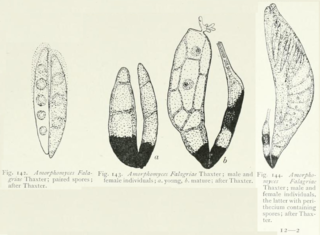
The Laboulbeniales is an order of Fungi within the class Laboulbeniomycetes. They are also known by the colloquial name beetle hangers or labouls. The order includes around 2,325 species of obligate insect ectoparasites that produce cellular thalli from two-celled ascospores. Of the described Laboulbeniales, Weir and Hammond 1997 find 80% to be from Coleoptera and the next largest group to be the 10% from Diptera. Recently, the genus Herpomyces, traditionally considered a basal member of Laboulbeniales, was transferred to the order Herpomycetales based on molecular phylogenetic data. Laboulbeniales typically do not kill their hosts, although they may impair host fitness if the parasite density is high.
Aporomyces is a genus of fungi in the family Laboulbeniaceae. The genus contain 8 species.
Aphanandromyces is a fungal genus in the family Laboulbeniaceae. This is a monotypic genus, containing the single species Aphanandromyces audisioi.
Apatomyces is a fungal genus in the family Laboulbeniaceae. A monotypic genus, Apatomyces contains the single species Apatomyces laboulbenioides.
Apatelomyces is a fungal genus in the family Laboulbeniaceae. A monotypic genus, Apatelomyces contains the single species Apatelomyces ogmoceri.

Amorphomyces is a genus of fungi in the family Laboulbeniaceae. A 2008 estimate placed 13 species in the genus.
Acrogynomyces is a genus of fungi in the family Laboulbeniaceae. The genus contain six species.
Acompsomyces is a genus of fungi in the family Laboulbeniaceae. A 2008 estimate placed seven species in the genus.
Acallomyces is a genus of fungi in the family Laboulbeniaceae. The genus contain three species.
Amphimyces is a fungal genus in the family Laboulbeniaceae. This is a monotypic genus, containing the single species Amphimyces cerylonis.
Diandromyces is a genus of fungi in the family Laboulbeniaceae. A monotypic genus, Diandromyces contains the single species Diandromyces chilenus.
Diplomyces is a genus of fungi in the family Laboulbeniaceae. The genus contain 3 species.
Dipodomyces is a genus of fungi in the family Laboulbeniaceae. The genus contain 2 species.
Hydrophilomyces is a genus of fungi in the family Laboulbeniaceae. It was circumscribed by American mycologist Roland Thaxter in 1908. The genus contain 12 species.
Sympodomyces is a genus of fungi in the family Laboulbeniaceae. A monotypic genus, it contains the single species Sympodomyces pentacellularis.
Stemmatomyces is a genus of fungi in the family Laboulbeniaceae. The genus contain 3 species.

Roland Thaxter was an American mycologist, plant pathologist, botanist, and entomologist, renowned for his contribution to the insect parasitic fungi—Laboulbeniales. His college education was completed at Harvard, where he dedicated forty years to mycological and botanical research. His five-volume series on fungi in the order Laboulbeniales laid a solid foundation of research on these insect ectoparasites. He also contributed to the field of Plant Pathology.
Cucujomyces elegans is a species of fungi in the family Laboulbeniaceae. It is found in Argentina.
Chitonomyces elegans is a species of fungi in the family Laboulbeniaceae.
Corethromyces elegans is a species of fungi in the family Laboulbeniaceae. A specimen at the University of Illinois Herbarium was found on Rhexius inculptus Lec. in La Salle County, Illinois, United States.



